Experiences from New York Kathak Festival

By Shivangi Dake Robert In December 2018, I got to know about the New York Kathak Festival. They were accepting applications from Kathak artists around the world and I sent in my application. In Jan 2019, I received a reply from the team which said “We enjoyed reviewing your application and are excited to share that you have been selected to perform at the 2019 festival”. I was over the moon on receiving this opportunity to perform a solo at the New York Kathak Festival ( abbr. NYKF) and started preparing. The New York Kathak Festival team did their best to promote the festival via social media. It was a first of its kind festival to be held in the city. A bunch of talented Kathak artists from the US and different parts of the world were selected to perform. I was excited to meet them and watch them perform. I was also thrilled to know that Padmavibhushan Pt. Birju Maharajji and Vidushi Saswati Sen didi were going to perform there and conduct an intensive workshop. I could not wait to go to New York. The NYKF dates were 19th April 2019 – 21st April 2019. It was a roller coaster ride to get the US visa but I finally got it! First time my visa application was rejected. Applied again, and second time, Visa approved!! Anisha, one of the main organisers of the festival and Urvashie were very helpful and made the process easier. Prepared and rehearsed a lot for my solo performance to be presented. Costume, jewellery, make up, ghungroo, hair accessories, all packed and ready to travel! On 16th April I boarded my flight from Singapore to NYC. Changed two planes and 22 hours later reached the Newark airport. Tired, jet lagged but full of anticipation and excitement. To reach my place of accommodation it took me two train rides and a long walk with a heavy suitcase from Columbus circle subway station, it was an adventurous journey. First two days in NYC were spent rehearsing and exploring the Manhattan neighbourhood, including some of the popular locations such as Central Park and Times Square. Spellbound by the vastness and beauty of these places, I was so tired in a couple hours that I went back to the room and got much needed sleep. Evenings were quite chilly for the month of April in NYC. NYKF Day 1 – Woke up refreshed after a restful sleep. It was the first day of New York Kathak Festival and the day of my performance. I practiced, got ready to attend Maharajji’s workshop. Packed my costume and ghungroos for the performance and headed to Ailey Citigroup Theatre, Manhattan, the venue for both the workshop and the festival. Reached the venue and met some wonderful new people, most of whom were from New York, New Jersey and some other parts of US. It was so good to meet Anisha, the main organiser and the core team of NYKF consisting of about ten people. They were such warm and wonderful hosts. Soon after, Maharajji and Saswati didi arrived for the workshop. I felt like the luckiest person in the room because my guru was right there in front of me. Post the workshop it was soon time to get dressed for the performance. All set and ready! I was one of the few artists to be performing that evening. I was both excited and nervous before going on stage. Maharajji and Saswati didi were the chief guests of the festival. To perform a solo in front of them and to receive Maharajji’s blessings for the performance was definitely a dream come true. My performance was in two parts – both original choreographies by yours truly. First part was a Kathak recital set to Brazilian jazz music and the second was a Kathak presentation on a semi-classical song involving the Sitar and guitar. The audience’s reaction with a roaring applause left me humbled and determined to work even harder to perfect my craft. Interviews, photographs and post performance meet-n-greet followed, overwhelming me with joy. I was grateful to the NYKF team for letting me be a part of their beautiful event. Day 2 – This day too started with meeting artists and art enthusiasts at the festival over breakfast. This was followed by Pt. Birju Maharajji’s workshop. It was such an enriching experience to learn from the maestro himself. So much to learn each time I meet the legend! Got to meet the well known tabla Guru Pt. Divyank Vakil, based in New Jersey, a few of his Kathak dance students were also a part of this festival. Later that day the line up of artists was quite interesting. One of the artists was New York based Kathak exponent Prashant Shah, a disciple of Padmavibhushan Kumudini Lakhiaji. Prashant and his disciples performed wonderfully, the show ended with a well deserved standing ovation. Day 3 – The most awaited day of the festival was here! Maharajji and Saswati didi were going to perform at the finale concert! The concert started with some of the most awaited performances of the festival followed by Saswati didi who performed a traditional Kathak solo and mesmerised everyone with her grace, intricate footwork and expressive story telling through various rhythmic patterns. The finale was concluded by Maharajji singing his beautiful compositions of thumris which left everyone absolutely spellbound! We couldn’t get enough of it, the evening ended with a standing ovation for the maestro. It was also the last day of the festival. It was not easy to say goodbye to the wonderful team of NYKF. Anisha, Urvashie, Meenakshi, Henna, were such wonderful hosts! But I was happy to have connected with some wonderful artists and people. With some time to spare before my flight back to Singapore, I decided to further explore the city of New York. I caught glimpses of iconic places like Times Square, One World Trade Centre, Rockefeller Centre and the Hudson River. Now it was time to pack up and get ready to catch my flight
Hidden Truths – Raja Ravi Varma: The Inside Story
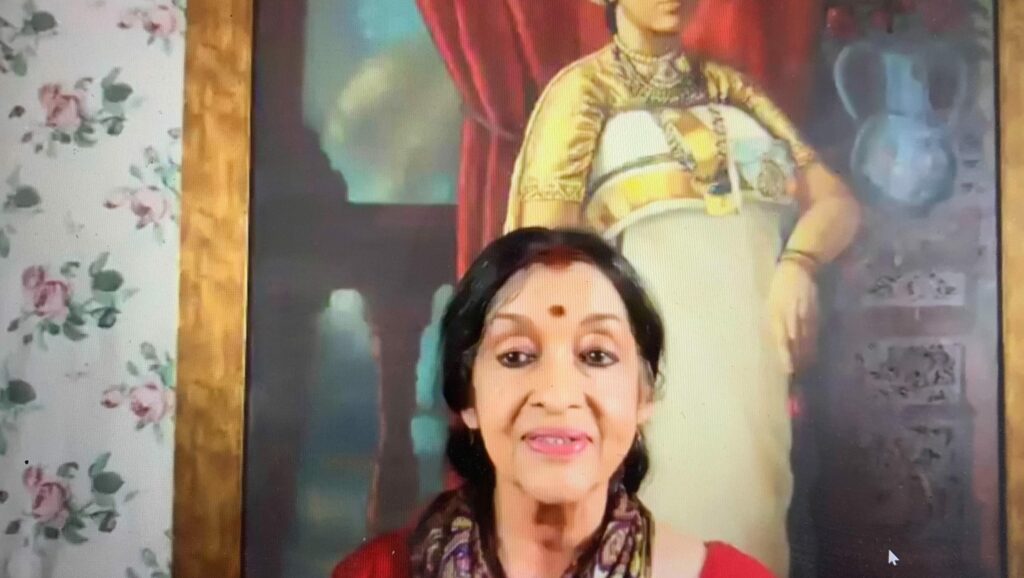
Featuring Mrs Rukmini Varma By Vidhya Nair The December edition of Spotlight Series on the 13th featured Mrs Rukmini Varma on the topic: Hidden Truths – Raja Ravi Varma: The Inside Story. The title comes from the book authored by the Mrs Rukmini Varma who is herself a leading Indian artist who paints in the classical tradition. Born in 1940 as Princess Bharani Tirunal Rukmini Bayi Thampuran of Travancore State, Rukmini is the great-great granddaughter of the master painter Ravi Varma and custodian of his artistic legacy through the Raja Ravi Varma Heritage Foundation. In her talk, she shared rare pictures of their ancestral home, Kilimanoor Palace in Thiruvanthapuram, Kerala and how the Travancore royal family lived. It was interesting to learn of Raja Ravi Varma’s birth and the prophecy of his contribution. She also reviewed a number of his notable paintings and shared his artistic techniques, use of colours, his appreciation of aesthetic beauty in his use of saree drapes, jewellery and his interpretations of significant events from the epics of Mahabharata and Ramayana. She also shared personal family anecdotes learned from her grandmother on Raja Ravi Varma’s challenges in gaining patronage for his art from other royal families around India and his relationship with the East India Company. She also shared the sadness and his sufferings with diabetics which ultimately claimed him in the years when he produced his best works. It was significant to note that he lived in the same time space as Swami Vivekananda when the West was taking interest in Indian culture, religion and the arts and the lasting contributions that these men made in their time and beyond. Mrs Rukmini Varma earnestly took time to answer questions from the audience of over 80 who keenly asked about the printing press he created in Mumbai, his foresight to have greater outreach to the masses and she shared that he considered it his life work to create a universal Indian identity and this was his way to unify India as a collective whole. This talk was made possible by the Raja Ravi Varma Heritage Foundation which is a not-for-profit institution that works to preserve and promote the artistic legacy of one of India’s greatest artists. The Foundation works in the space of research, documentation, authentication and education with regard to Ravi Varma and his art works and does not trade in the work of the artist but collaborates with public and private museums, collectors to promote Ravi Varma’s artistic contributions. This talk was held in conjunction with the premiere of Apsaras Arts’ SITA – selected paintings by Raja Ravi Varma, a first of its kind digital dance film production which was screened at Esplanade Recital Studio in 3 separate sessions on 20 December 2020 to full-house audiences and rave reviews.
Audience Reviews of SITA by Apsaras Arts
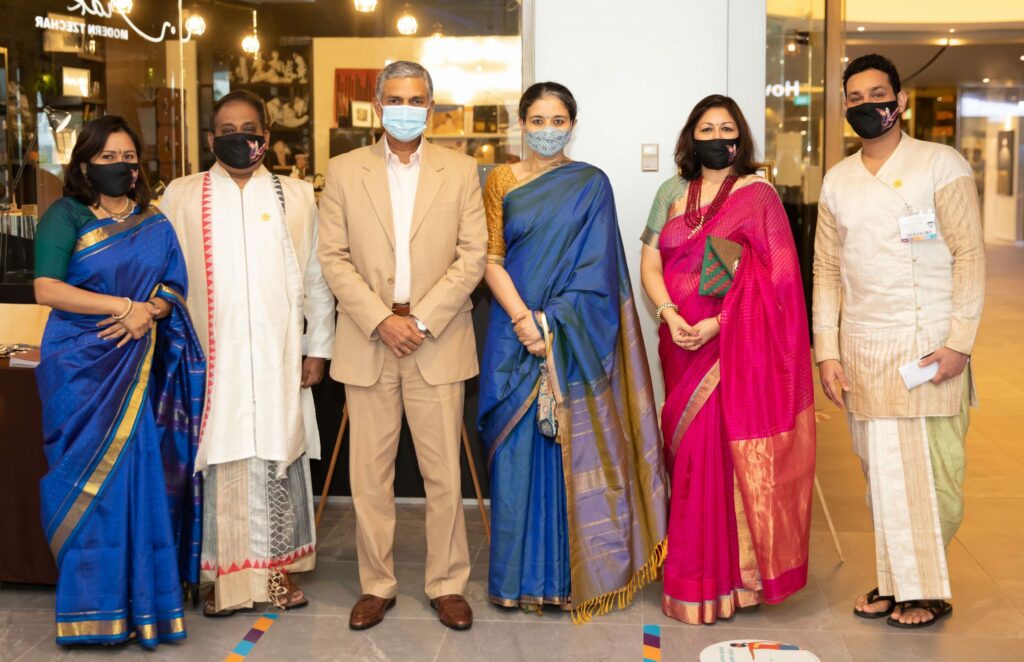
SITA – Insight into the life of Sita By Meenakshi Palaniappan Was bliss to be back at the Esplanade yesterday to watch Apsaras Arts Dance Company ‘s digital production of Sita. We got a glimpse into Ravi Varma’s beautiful paintings and watched the art come alive through dance. The production took us back to our rich mythology, not just to celebrate but also to ponder and be disturbed by some aspects. Ramayana is beautiful but Sita’s voice is silent for much of the text. Ravi Varma’s paintings allow us to wonder about Sita further, what might have gone on in her mind. The dance brought these ‘wonderings’ to life. While all the “painting dances” were beautiful, it was the piece where Ravana abducts Sita and where Mother Earth takes back Sita that really moved me. For the former, Sita’s captivity was emphasised by the fact that the dancer could only move as Ravana did and only within a small radius. Furthermore she had her hands behind her back much of the time. Hand movements are very much part of Bharatanatyam, so for the dancer to dance with her hands ‘tied’ really conveys Sita’s lack of freedom. Her face was full of agony, yet that dance was so graceful. Just masterful. For the latter, ah, the mother daughter duet was touching, heart wrenching in fact, for it showed how Sita found unconditional love with her mother, not her husband. Kudos to the team and thank you for a beautiful piece. Looking forward to many more Aravinth Sir! SITA Beautiful Blend of Technology and Dance By Vidhya Venkat It is almost a week since we saw SITA – selected paintings by Raja Ravi Varma by Apsaras Arts. Firstly it was so refreshing to be back at the Esplanade recital studios , meeting some live audience and watching this digital production after a gap of many months. SITA is a first in many aspects – digital CGI production , remote control between Singapore and India , all costumes had to be made in Singapore – these are probably a few . To me,it was a beautiful blend of technology and dance . It was a seamless blend . Each painting sprung to life and went back once the dance was over . I found that fascinating . There were a lot of moments in the production which made an impact on me personally. – the part where Rama n Sita meet for the first time with the song Annalum Nokkinaal avalum nokkinal .. -the part where Ravana lifts Sita . The graphics were very well done. -Sita in Ashokavanam when she asks – Was it all a mirage ? -the last scene when Rama pleads with Sita and she implored Mother Earth to take her back . The choice of a thillana there was just perfect. These are just a few of the things which stood out . There are many more . This production just stands to prove that arts has survived the Covid crisis to a great extent. This production was turned around to suit the times . It was a big challenge to get the dancers, dance without any sets , just a green floor and cameras around and having to have them turn around in many directions. The musicians and composers sitting in Chennai and belting out a wonderful score. As always brilliant music by Sri Rajkumar Bharathi sung more beautifully by Bombay Jayashri , G Srikanth and Keerthana Vaidyanathan, music direction by Sai Shravanam, filming and editing by Visual Beats Ltd , Choreography and costumes at its best by none other than Mohanapriyan Thavarajah and creative direction by Aravinth Kumarasamy. A special shout out to the members of Apsaras who have been part of this production. And finally congratulations to all the SITAs – Kshirja Govind, Nikita Menon, Ashmita Jayaprakash, Janani Arunkumar and Devapriya Appan . Other dancers – Maanasa Sri Ganesh, Periyachi Roshini, Meera Balasubramanian as Bhumidevi and of course Mohanapriyan as Rama and Ravana . An afternoon extremely well spent and left the mind wanting to know more and understand more. Congratulations Team SITA.
National Award for Apsaras Arts Dance Company
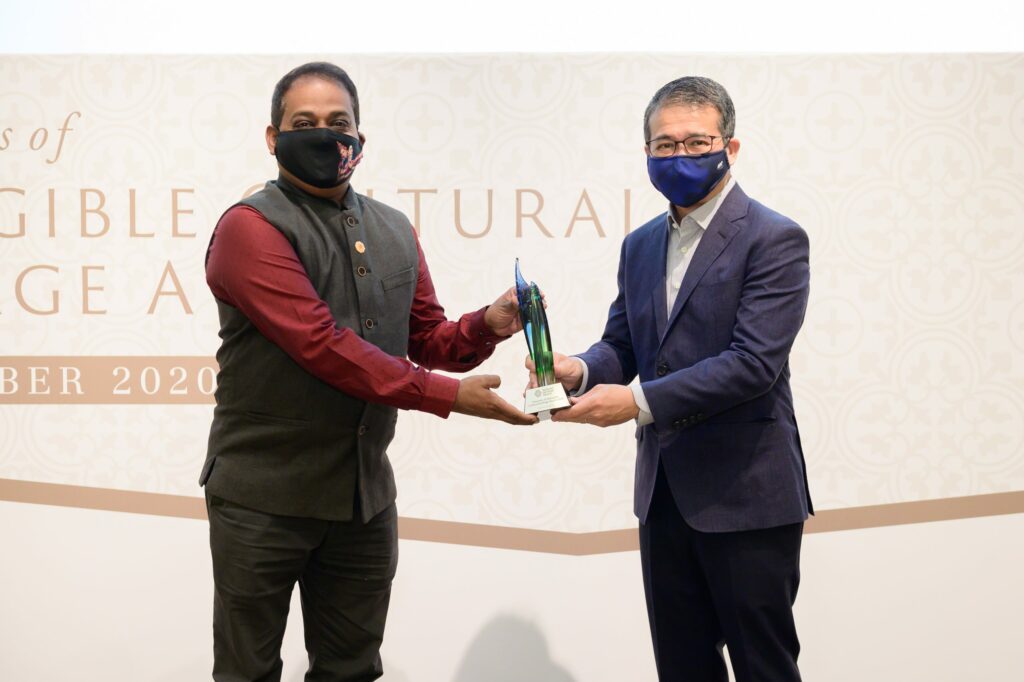
Presented by National Heritage Board of Singapore on 10th December 2020 Acceptance speech by Aravinth Kumarasamy, Artistic Director of Apsaras Arts Dance Company. “Dear Guest of Honour, Minister of Culture, Community and Youth, Mr. Edwin Tong, Ms. Yeoh Chee Yan, Chairman of NHB, and Ms. Chang Hwee Nee, CEO of NHB. Good afternoon. Receiving this award for Apsaras Arts has invoked us with the rasas of Endorsement, Encouragement and Excitement This award is an endorsement to the vision of our founders Mr S Sathyalingam and Mrs Neila Sathyalingam, pioneers of the arts in Singapore, and for what they had envisioned for Apsaras Arts when they founded the institution 43 years ago in 1977. We humbly dedicate this award to their memory. This award is an encouragement to the current generation of Art makers of Apsaras Arts for their dedication to preserve, evolve the art form to make it relevant and hand it down to our next generations of Singaporeans. This award has also invoked excitement to all those who are involved in Indian Dance as its an honour to have Indian dance considered as one of the Intangible cultural heritage of our nation. Indian dance has been practiced in Singapore for the past 100 years, and has its origins in India, and were very surprised at the excitement that was seen in India when this award was announced in Singapore a few months ago, and the Indian mainstream media covered this Singaporean story on the front pages of their daily newspapers. We are hopeful that our very own mainstream media too will be excited to cover traditional arts with excitement in the near future. I would like to congratulate NHB for instituting this award to celebrate our very own heritage, giving the due recognition to its practitioners and custodians. Thank You. I would like to congratulate our core team at Apsaras Arts – Our board members led by our chairman Ambassador K Kesavapany, our team of art makers – Seema Hari Kumar, Devapriya Appan, Mohanapriyan Thavarajah (who will be performing for you today) and to our dedicated art managers Vidhya Nair, Vijaya Nadesan and Sankari Elavalahan who are the back bone of our team, who are all present here today. I would like to acknowledge and thank National Arts Council for holding our hands in this journey. Without their support, Apsaras Arts would have not be able to work on its mission to towards its vision. Thank you NAC.
G Selva – A multi-personality artiste driven by passion & ambition
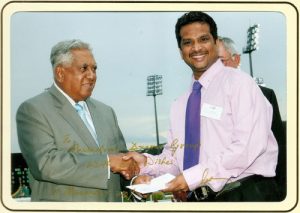
Exclusive Interview with Vidhya Nair “We should know that the audience out there is intelligent and discerning and patrons expect value for their time. To receive a worthy compliment from the audience is GOLD.” G Selva is a well-known media personality & theatre practitioner in Singapore. From a young age, he has performed as an actor on television and theatre. Today, he is an accomplished director & playwright of his own theatre company, Avant Theatre & Language which will be celebrating its 10th year anniversary in 2021. He is also an alumnus of Apsaras Arts since the 1990s. A tête-à-tête with him this month brought insights to his life’s journey and his varied artistic achievements and ambitions. VN: When did your interest in the arts happen? Was this something you were exposed to in your family in your youth? GS: There was no one involved in the arts in my family. As the only son with 4 sisters, my parents saw me blossom as a television actor from a young age. They were supportive and appreciated my talents and this led to opportunities to perform in theatre and radio. Among friends, we created a small like-minded dance group and decided that we could try something new in performance. We focused on creative movements and called ourselves “Shazeen” and in time, we started to get calls for live performances and programs at the Community Centres.https://www.youtube.com/embed/WxRv-waSQNYThere, I met Deva Charles (featured in November 2020’s Avarthana interview) who was working at Radin Mas community centre under People’s Association and that’s how I came to meet Neila Mami. Dance and performing by then had become my every Tuesday & Thursday lifestyle. I was hooked to the arts and by the late 80s, I knew this was where I wanted to be. VN: You had a long association with Neila Mami. What are your memories of her and do share your experiences with her? GS: I worked with her in People’s Association shows for 10 years. I think she identified my abilities to perform early on. Perhaps it was my “Indian face” so I was cast in many significant roles in many of her productions like “Kurma Avartharam” & “Shiva Kalyanam.” I think she found that I picked up movements and showed interest easily even though it was very tough to transition to performing classical dance. But my greatest admiration for Mami was her ability to teach and her talent in “packaging.” For me, that was the key ingredient to her success. She was always mindful of the audience perspective and she invested in creating choreography that brought out the strength of characters that would have audience appeal. We have to remember that back in the 1980s-90s, embracing multiculturalism while having an international perspective (She engrossed herself in all aspects from costumes to instrumentation of her productions) yet mindfully retaining a Singapore identity in all her creations. I connected completely with her ideology. It was this grooming as a dancer by Mami that brought me to theatre.https://www.youtube.com/embed/G9D9fUBasYYVN: You are now entrenched in Tamil Theatre for over 20 years now. Tell us how you entered this space. GS: Back in 1988, I was involved in the earliest work by then Ravindran Drama Group (RDG) in a play, “Kudumbatil Allaigal.” I realised that I enjoyed the attention I received on stage. Theatre appeals to me because it brings forward shades of colours, storylines, social themes and this visibility drew me to the craft and best of all, audience interactivity and immediate response. I think I’ve always been an attention seeker but I saw how theatre moulded people and that helped my transition from being an actor to a director. At the same time, I also started to host shows on television. It was a time when I was enjoying the popularity and glamor yet I was seeking to find my correct calling. I found direction when I met my ex-wife who was pursuing her PhD in Malay theatre in Australia. We got married in 2001 and I received an NAC scholarship to pursue my degree in Media Arts & Drama from Deakin University, Melbourne. I was there till 2009, where I also taught in the same Deakin University, a course in Cultural and Global studies which incorporated theatre methodology and techniques. I also launched Avant Theatre, Australia in 2001 where we explored daring themes working with Australian artistes. My pride and joy, two beautiful daughters – Nirtha (Pure Dance gestures) and Shastra (Inscription) were also born during this time. By 2007, I had graduated and grown restless and occasionally return to Singapore on media and theatre invitations. In 2006, I was invited as a judge for a TV show “Dhool” produced by MEGASTAR productions by Mr V Kalaichelvam which is a National level Dance Competition for TV. A major impetus upon my return in 2007 came from Neila Mami, whom I had kept in touch with throughout my years overseas, who called me in to advice and support her magnum opus production, “Sivagami.” She was designing it as a Theatre-Dance production. I was involved in engaging the theatre director initially and finally she handed the portfolio to me to be her theatre director, as by then I knew exactly what was required for the job and this was her Cultural Medallion dream production. “Sivagami” was an opportunity that helped me cement my own calling to consider theatre seriously. It reminded me of a piece of advice that Satyalingam Mama told me on a trip to Macau in the 90s when he said,” You are lucky because you have Mami as your Guru, she has given you a Parampara, an important lineage to follow, for you to be in the arts.” I used to enjoy watching Mami and Mama during their interactions where they could argue intellectually about artistic freedoms and creativity. They always displayed their passion & chemistry and it intrinsically came to be transported to her students, like me. VN: Avant Theatre & Language, Singapore was formed in 2011. Now your company is almost
A Lawyer’s Legend : E. Krishna Iyer
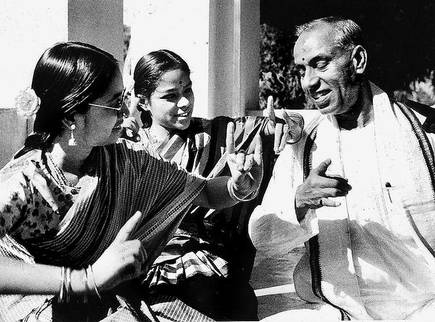
By Naatyaachaarya. V.P.Dhananjayan In the fifties and sixties the name of E.Krishna Iyer was a household name in erstwhile Madras, now called Chennai. He was seen in every Bharatanatyam and Sangeeta Kutcheries(concerts) by known and well known performers of those days. Not very many happening like these days, Arangetrams (debut) were very rare occurrences but E.Krishna Iyer with his hearing aid sitting in the front row and commenting in a loud voice was a common sight. His reviews in the Hindu front page was a great moment for all artists to cherish. He did not spare his pen to make bold criticism of young and old performers. Everyone knew who he was and what his contributions were to the upliftment of fallen art forms and a steadfast Congressman taking part in freedom fight meetings and processions in his immaculate white khadar veshti & jubba. A strong pillar of the Madras Music academy drew instant respect from all quarters of that generation. He moved the resolution in the Academy to rechristaine ‘sadirattam’ to Bharatanatyam. My memories of him as an adolescent boy is very vivid and many a times listened to his sermons and reprimands. He used to visit Kalakshetra very often and interact with Smt. Rukminidevi who were great friends of course. Both of them are responsible for the resurrection of a fallen profession back to the divinity and dignity of Bharatanatyam . He never missed any of Kalakshetra productions and write about them in the Hindu news paper (those days The Hindu carried reviews on the front page and so much of importance was given for all art, artistes and art activities) I don’t know whether he had a soft corner for me as an upcoming young Nartaka (male Bharatanaatyam dancer) and delivered encomiums of my performance as Sriraama in the Ramayana series of Kalakshetra. But what I cherish more, are two very great reviews of him on my performing as a ‘Poojaari(priest) Kannappar kuravanchi (a very insignificant role eulogised ) and the Brahmin who brings a love letter from Srikrishna to Rukmini (also an insignificant role) in the Bhagavatha mela “Rukmini swayamvaram” – he devoted one para of comments on these, not so important characters, living aside the main characters. Once he called me to his office in Tamizhnaadu Eyal Isai Nataka Mandram (The State Academy) and talked generously about how difficult it would be for a man to make a career as Nartaka. Quoted the example of Ramgopal, Nalanajan and the like who had to leave the land for a greener pasture. He vehemently advised me to create a Bharatanaatyam repertoire that will project the manly emotions instead of handling feminine natured repertoire akin to women’s nature, that may look effeminate in a male body. Following his sincere advice, when I started performing Bharatanaatyam solos and duos with Shanta I restricted myself to male oriented songs of Bhakti, Veera and Sringaara. E.Krishna Iyer’s name should be etched in gold letters in the history pages of Bharatanaatyam like Smt. Rukmini Devi
A GRAMMAR OF DANCE
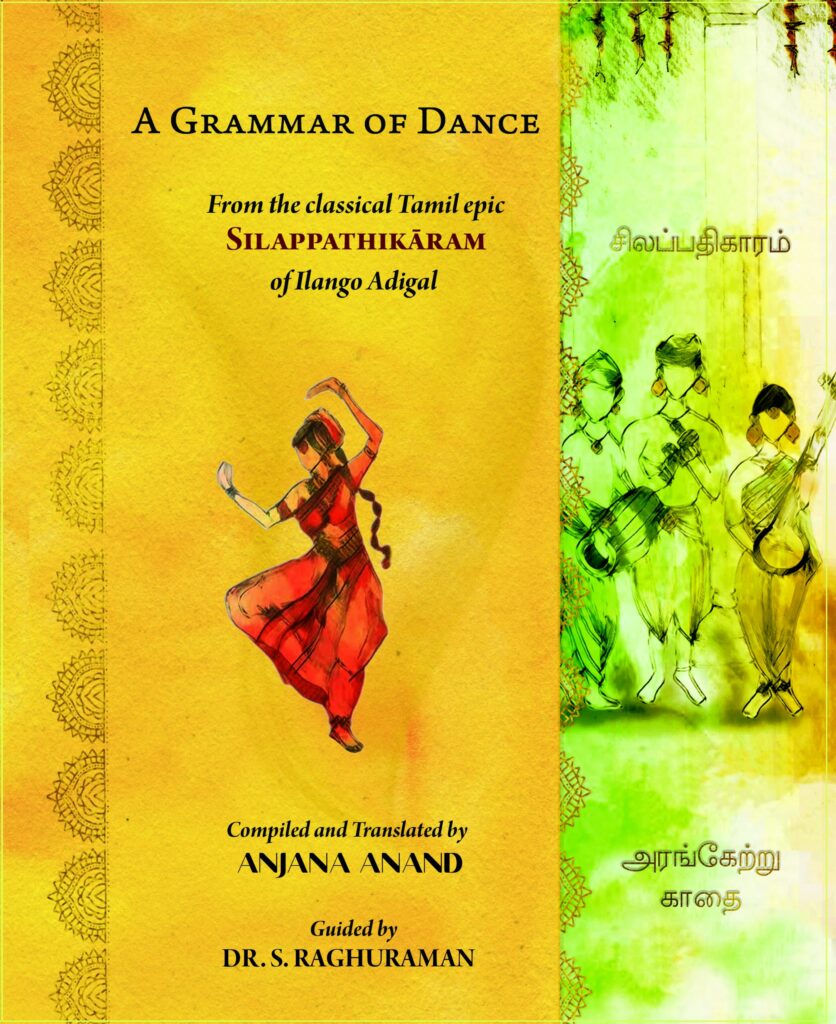
By Anjana Anand The Silappathikāram of Ilango Adigal (1AD) is a treasure-house of cultural information from the Tamil land of almost 2000 years ago. A Grammar of Dance looks closely at the third canto, Arangētru kādhai, which talks about the arangetram or debut performance of Madhavi, a courtesan in the Chozha court in Puhar. Ilango Adigal outlines the merits of a trained dancer, which include detailed knowledge of the technique of Kūtthu and its allied art forms. While Ilango Adigal briefly alludes to these aspects in this epic which traces the star-crossed lives of Kovalan, Kannagi and Madhavi, it is the commentaries by Arumpada Uraiyasiriyar (10 AD) and Adiyarkkunallar (12 AD) written a thousand years later that shed more light on the technical terms mentioned in the Arangētru kādhai. A Grammar of Dance is the first published English translation of Ilango Adigal’s Arangētru kādhai along with its commentaries. These commentaries contain detailed insights which will allow connoisseurs of dance and culture to immerse themselves in a rich art form that is millennia old, and yet preserved for posterity through careful documentation. Please contact Sahrdaya Foundation ( +91 9499926649 ) to collect your copies. Price: Rs 500 (courier charges applicable) Anjana Anand An alumna of SIFAS, Singapore and Kalakshetra College of Fine Arts, Chennai, Anjana is a Bharatanatyam performer and teacher presently under the mentorship of Sheejith Krishna. Anjana is the co-founder of Sahrdaya Foundation. Her interest in academics led her to complete a Masters in Fine Arts (Bharathidasan University, Tiruchirappalli). She is currently working on a Ph.D. in dance studies with a focus on rasa theory under the guidance of Dr. S. Raghuraman (Bharathiyar University, Coimbatore).